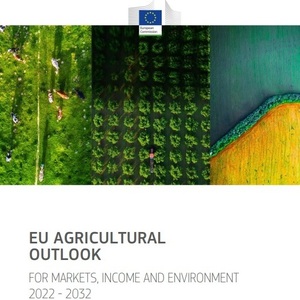EU ag outlook includes forecasts for biodiesel, ethanol demand

January 17, 2023
BY Erin Krueger
The European Commission has published its annual EU agricultural outlook, which includes projections for biofuel use through 2032. The outlook predicts stable biodiesel use in the medium-term, with increased ethanol use through 2030.
According to the report, expected EU demand for biofuels is directly linked to demand for road transport fuels and obligatory fuel blending rates. When compared to 2020-2022, diesel use is expected to fall by 21 percent by 2032. Gasoline use is expected to fall by 18 percent over the same period.
Advertisement
Advertisement
Despite the expected decline in transportation fuel use over the next decade, the European Commission predicts that projected increases in blend rates will boost demand for biofuels. Demand for biodiesel is currently expected to stay relatively stable at approximately 20 billion liters (5.28 billion gallons) per year. Ethanol demand is expected to increase to 7.7 billion liters per year in 2030, up 11 percent when compared to 2020-2022, before falling to 7.4 billion liters per year in 2032.
The share of palm oil used as biodiesel feedstock is expected to fall from 23 percent in 2019-2021 to 9 percent in 2032. The report cites requirements to certify indirect land use change (ILUC) as the reason for the expected decline. The use of other vegetable oils is expected to remain relatively stable at approximately 50 percent of biodiesel feedstock, according to the report. The share of advanced biofuels is expected to increase from 29 percent to 42 percent, with the share of waste oils and fats expected to increase from 23 percent o 26 percent and other advanced biodiesels from 6 percent to 16 percent. In the report, the European Commission attributes the expected changes in feedstock use to specific fuel blending targets for advanced biofuels and the fact that those advanced biofuels can be double counted towards the overall mandatory blending targets.
Advertisement
Advertisement
For ethanol, corn is expected to remain the primary feedstock. It’s share of total ethanol feedstock, however, is expected to fall from 45 percent to 33 percent. The total share of crop-based feedstocks is expected to fall from 90 percent in 2019-2021 to 72 percent by 2032. The share of waste and residue-based feedstocks is expected to increase from 7 percent to 15 percent over the same period. Production from other sources is expected to increase from 3 percent to 12 percent.
A full copy of the outlook is available on the European Commission’s website.
Related Stories
Neste Corp. on July 24 released second quarter results, reporting record quarterly renewable product sales volumes despite weaker margins. SAF sales were up nearly 80% when compared to the first quarter of 2025.
Valero Energy Corp. on July 24 released second quarter results, reporting a profitable three-month period for its ethanol segment. The renewable diesel segment posted a loss, but the company’s new sustainable aviation fuel (SAF) unit operated well.
The IRS on July 21 published a notice announcing the 2025 calendar-year inflation adjustment factor for the Section 45Z clen fuel production credit. The resulting adjustment boosts maximum the value of the credit by approximately 6%.
The U.S. Senate on July 23 voted 48 to 47 to confirm the appointment of Aaron Szabo to serve as assistant administrator of the U.S. EPA’s Office of Air and Radiation. Biofuel groups are congratulating him on his appointment.
U.S. Secretary of Agriculture Brooke L. Rollins today announced the reorganization of the USDA, refocusing its core operations to better align with its founding mission of supporting American farming, ranching, and forestry.
Upcoming Events










